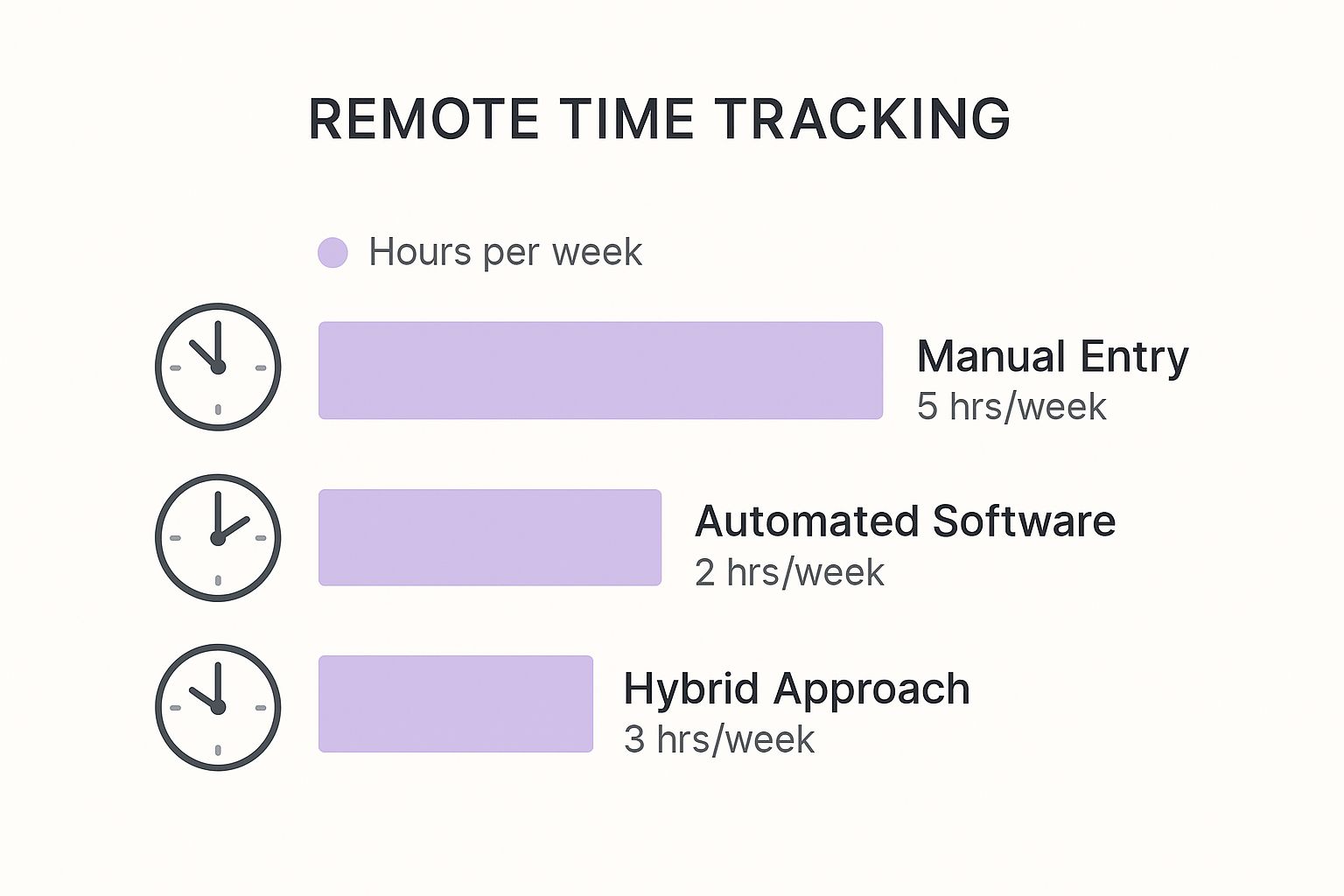
Let's be real. Effective remote employee time tracking isn't some corporate surveillance fantasy. It's the lifeline that brings sanity to payroll, keeps you out of legal hot water, and shows you where your team's most valuable resource—time—is actually going. It has far less to do with spying and much more to do with operational clarity, especially when you're managing a team you can't see.
The big shift to remote work wasn't some grand, deliberate strategy for most companies, was it? It felt more like we were all shoved off a cliff and told to build a parachute on the way down. One minute you're managing by walking around, the next you're juggling a team scattered across different states, wrestling with bizarre time zones, and realizing that old honor system feels… well, a little naive.

This isn't about becoming Big Brother. It’s about getting back the operational visibility you lost when everyone packed up their ergonomic chairs. More than anything, it’s about being fair—to your business, your budget, and your people.
Without a clear system, you're flying blind. And hope is not a strategy. The U.S. economy alone bleeds an estimated 50 million productive hours every year from undocumented work. That's a staggering amount of money vanishing into thin air, and that number has only climbed with the rise of remote teams.
A solid time-tracking solution solves some very real, very expensive problems. Think of it as the foundation for:
The goal isn't to micromanage every single keystroke. It's to get an honest picture of your company's most valuable asset—your team's time. You simply can't manage what you don't measure.
At the end of the day, tracking time is just one piece of a larger productivity puzzle. It works best when paired with broader strategies, like implementing effective time management schedules for your team. For any remote-first company ready to operate like a serious business, moving beyond those chaotic spreadsheets isn't just a good idea—it's non-negotiable.
Picking a time tracking tool for a remote team can feel like you're wading through a swamp of over-marketed features. Do you really need keystroke logging and random screenshots? Or are you just looking for a glorified start/stop button?
The answer really depends on whether you want to build a culture of trust or a culture of resentment.
Frankly, most platforms fall into two camps: they're either too basic to be useful or so complicated they require a PhD to operate. I've tested my fair share, and the tools that get an instant "no" from me are the ones that feel like they were designed in a dungeon—clunky, invasive, and built for surveillance, not support.
The goal isn't to find software that turns your company into a police state. It's to find something that genuinely fits your culture.
This infographic breaks down just how much of an administrative time-suck different tracking methods can be.

As you can see, relying on manual entry is a huge drain. Automated software, on the other hand, slashes that administrative overhead.
Let’s get one thing straight: you're choosing a business tool, not an interrogation device. The temptation to monitor everything is strong, especially when your team is out of sight. As of 2025, over 73% of employers are actively monitoring remote workers, and many tools offer some pretty creepy real-time activity tracking. But just because you can track every click doesn't mean you should.
The minute you weaponize time tracking data—using it to question bathroom breaks or time between tasks—you've lost. You’ll get compliance, sure, but you'll have torched trust and morale in the process.
Instead of getting distracted by shiny, invasive features, zero in on what actually moves the needle for your business.
When you're comparing software, it’s easy to get lost in a sea of features. This table cuts through the noise and separates the absolute must-haves from the "nice but not necessary" extras.
| Feature Category | What It Is | Who Needs It | Red Flag to Watch For |
|---|---|---|---|
| Payroll Integration | Automatically syncs tracked hours with your payroll system (e.g., Gusto, ADP). | Everyone. This is non-negotiable for any business paying hourly employees. | Tools requiring manual CSV exports. That’s just inviting errors. |
| Project Tracking | Allows employees to assign time to specific projects, clients, or tasks. | Agencies, consultancies, and any team that needs to track project profitability. | Clunky interfaces that make it hard for staff to switch between tasks. |
| Reporting & Analytics | Generates reports on time allocation, project budgets, and team productivity. | Managers and leadership who need data to make strategic decisions. | Basic reports that only show total hours. You need actionable insights. |
| Activity Monitoring | Tracks app/website usage, takes screenshots, or logs keystrokes. | Highly regulated industries or roles handling sensitive data. Use with extreme caution. | Any tool that markets this as its primary feature. It screams mistrust. |
| Mobile App | A functional app for tracking time on the go from a phone or tablet. | Teams with field staff, frequent travelers, or anyone who isn't glued to a desk. | A buggy, poorly-rated app. If your team can’t rely on it, it’s useless. |
Focus on the first three: payroll, project tracking, and reporting. Get those right, and you have a solid foundation. The other features are secondary and depend entirely on your specific operational needs and, more importantly, your company culture.
This strategic approach is a core part of a much bigger picture. Effective time tracking is just one component of a solid suite of remote workforce management software that should also handle HR, payroll, and compliance seamlessly.

Here’s a scene I’ve seen play out too many times: a sterile, company-wide email from HR announces a new “productivity monitoring tool,” effective Monday. By Tuesday, half your team is polishing their resumes and your top engineer just accepted a counteroffer. This is exactly where most companies trip over their own feet.
The rollout is everything. If you approach implementing remote employee time tracking as just a tech problem, you've already lost. This is a people problem first and foremost, and it demands a communication strategy, not just an installation guide.
Get this wrong, and you’ve just mortgaged your company culture for a timesheet. But get it right, and your team will see it for what it should be: a genuinely useful tool.
First things first, stop calling it "monitoring." The language you use sets the tone for the entire initiative. This isn't about a lack of trust; it's about bringing clarity, fairness, and efficiency to how you operate.
Your entire messaging strategy needs to be built around the benefits for them. Try framing it like this:
Your goal should always be adoption, not enforcement. The moment your team believes the tool is there to catch them making a mistake, you've failed. It needs to be seen as a system that protects their time and ensures fair compensation.
Whatever you do, don't roll out a new tracking tool to the entire company at once. That’s just asking for chaos. Instead, start small with a pilot program and a handful of trusted employees.
Here’s my go-to playbook for this:
This simple approach transforms your team from being passive recipients of a new rule into active participants in finding a solution. When the broader rollout finally happens, you’ll have a group of internal champions who can vouch for the system because they helped build it.
A shiny new tool without clear rules of the road is just an expensive subscription gathering digital dust. I’ve seen it happen more times than I can count. You can’t just buy some software, send a memo, and expect everyone to magically fall in line.
You need a simple, unambiguous policy that answers the inevitable "what if" questions before they clog up your Slack channels.
Think of this as the constitution for your remote work hours. It's not about creating rigid bureaucracy; it's about setting clear expectations to prevent disputes down the line. Everyone needs to know how to play the game, whether they're in Toledo or Tokyo.
Your policy doesn't need to be a 50-page legal document. It just needs to be clear, fair, and cover the essentials. Forget the corporate jargon and focus on practical scenarios your team will actually encounter.
Here are the absolute must-haves:
The best time tracking policies are written for humans, not lawyers. They are simple, easy to find, and anticipate real-world situations instead of pretending they don't exist.
Ultimately, your policy is your first line of defense against payroll errors and legal headaches. Getting these basics right ensures that your remote employee time tracking system is a tool for clarity, not a source of constant confusion and frustration.

Alright, this is where the hard work really starts to pay off. Getting your remote employee time tracking dialed in is the foundation for two things that keep every founder up at night: painless payroll and bulletproof legal compliance.
Nail this part, and you can finally say goodbye to manual data entry, frantic spreadsheet hunts at the end of the month, and those costly human errors that always seem to surface at the worst possible time.
The dream is simple: a smooth, automated flow of data from your time tracker straight into your payroll system. No more exporting CSV files, no copy-pasting, and definitely no last-minute "Wait, did Sarah work on Memorial Day?" guesswork. A native integration isn't just nice to have; it's non-negotiable.
This automation does more than save you time—it saves your sanity. It guarantees your team gets paid correctly and on time, which is the absolute minimum for building a culture of trust.
Getting payroll right is the most basic promise you make to your team. Automating it with accurate time data is how you keep that promise without pulling your hair out every two weeks.
Once your team is spread across different states or countries, you're not just running a company; you’re moonlighting as an expert in comparative labor law. The remote work boom has forced companies to get serious about time tracking, especially with regulations getting tighter every year. An automated system that can flag potential slip-ups, like a missed break, is a must.
Beyond the usual labor laws, it's crucial to understand specific Data Processing Addendum (DPA) requirements for handling all the employee data your time tracking system collects.
This isn't the most glamorous part of building a business, but getting it right means you can sleep at night without worrying about those dreaded letters from the Department of Labor. For a deeper dive, our comprehensive https://lathire.com/payroll-compliance-checklist/ will help you make sure all your bases are covered.
Let's cut to the chase. Once you start getting serious about remote employee time tracking, the same questions and anxieties always pop up. Here are the direct, no-nonsense answers you need to navigate those tricky conversations with your team and your leadership.
Generally, yes—it's legal to track time and activity on company devices during work hours. But the laws vary wildly by state and country, so don't just assume you're in the clear.
The one non-negotiable rule is transparency. You absolutely must have a clear, written policy that employees acknowledge, detailing precisely what you're tracking and why.
Don't even think about tracking during non-work hours or capturing sensitive personal data. Honestly, your best move is to have a legal pro review your policy to ensure it's compliant everywhere your team is based.
It's all in the framing. If you introduce it as a "monitoring tool," you've already lost. You need to position it as a system for operational clarity and fairness, not surveillance.
Focus on the benefits to them:
When you involve your team in the process and they see it as a tool that protects them from burnout while ensuring fair compensation, the conversation shifts. It goes from "you don't trust us" to "this helps us work smarter."
Easy. They weaponize the data.
The second you use time tracking reports to publicly call out an employee for being "unproductive" or to micromanage their every five-minute break, you've detonated your company culture. This data is for spotting high-level trends, managing project budgets, and identifying burnout risks—not for individual performance reviews.
Treat it as a diagnostic tool for the business, not a weapon against your people. Focus on outcomes, and let time data be a supporting metric, not the only one that matters.
